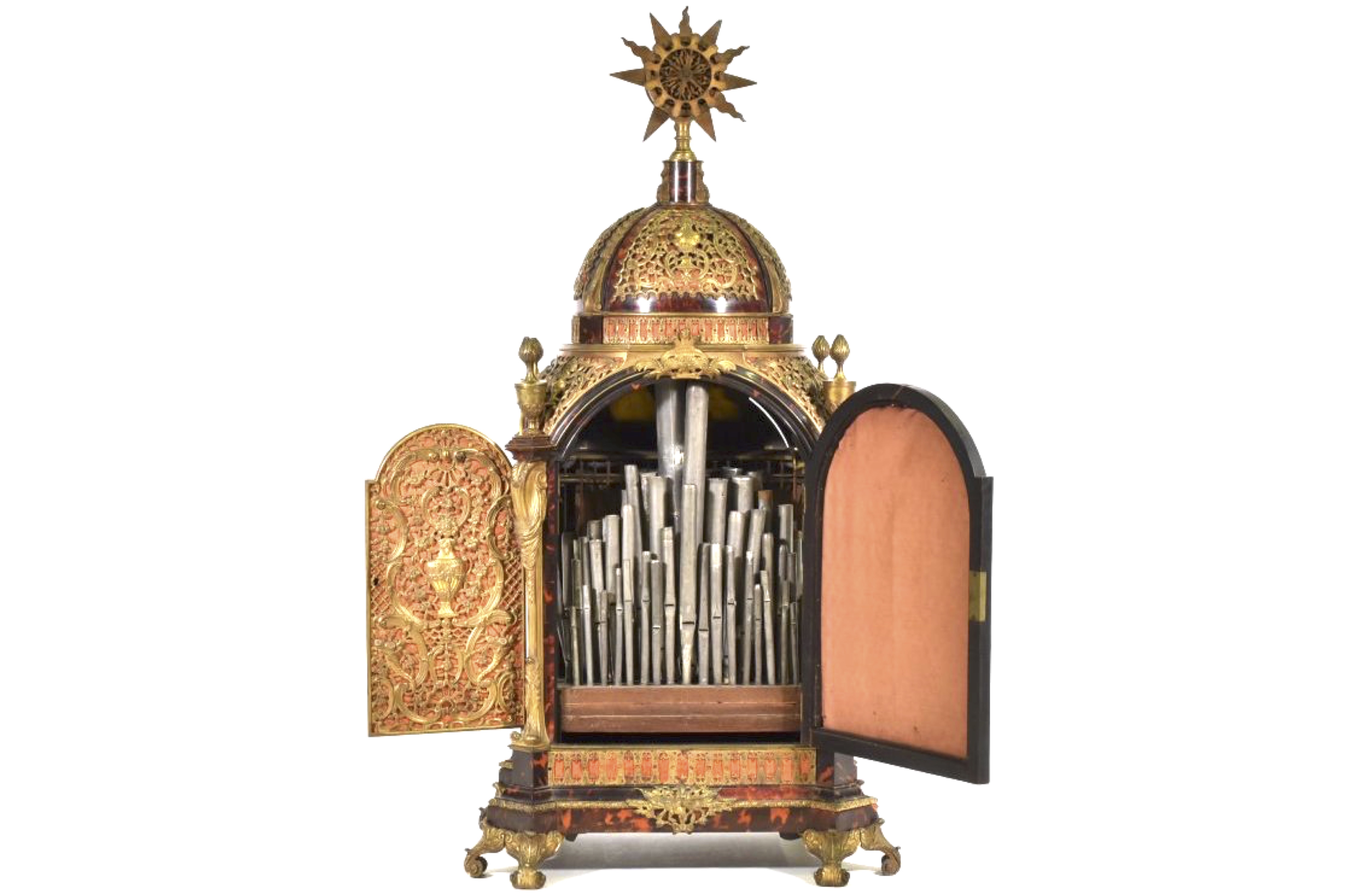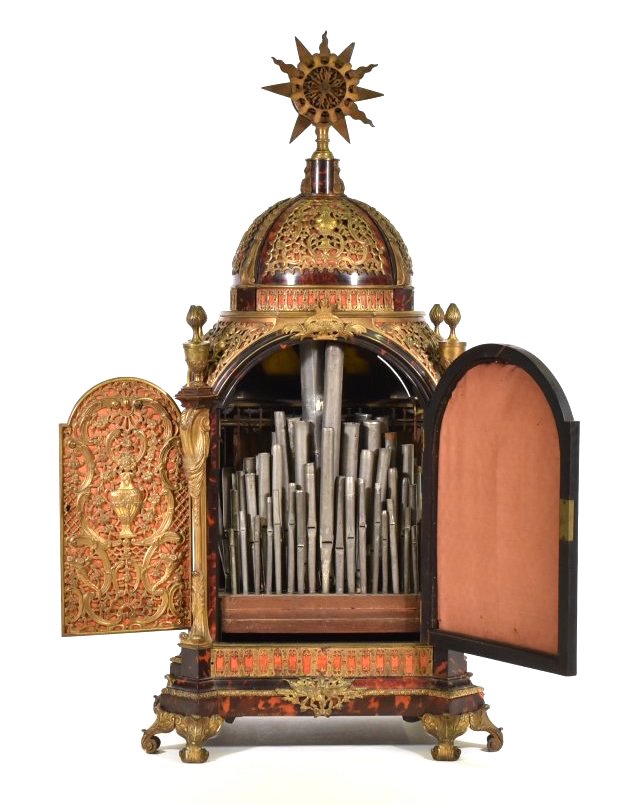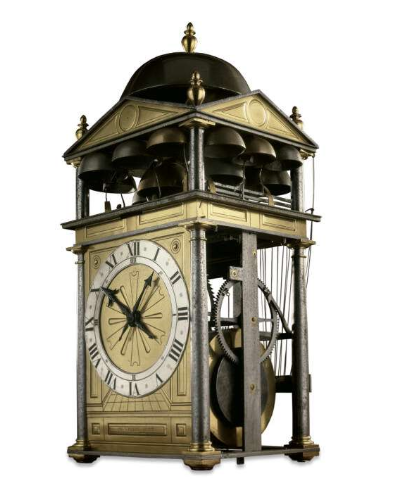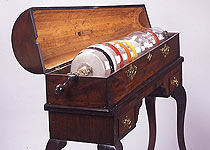


December 13, 2020
RICHARD BRASIER
–––––––––––––––––––––––––––
The Organ, and Mechanical Music Making during the Classical Period

December 13, 2020
RICHARD BRASIER
–––––––––––––––––––––––––––
The Organ, and Mechanical Music Making during the Classical Period

An organ clock by Markwick Markham, c. 1770.
An organ clock by Markwick Markham, c. 1770.
Although not much significance can be attached to the Classical period as far as composition for the organ is concerned (compared to earlier periods, at least), it was a time where mechanical music making was becoming increasingly popular.
The music of the German High Baroque reached its zenith during the mid-eighteenth century, thanks to the compositional genius of Johann Sebastian Bach, and his death at the age of 65 in 1750 left what we now might view as a huge void in the world of organ music. What happened to the musical landscapes of Germany and Austria in the years following the death of J.S. Bach is fascinating, and this article will aim to offer an insight into some of the musical changes that took place during the Age of Enlightenment, and to explore the colorful world of the Classical period.
Our starting place is with the music of J.S. Bach’s second eldest and most famous son, Carl Philipp Emanuel Bach. Although well-known among keyboardists, chamber musicians, and scholars of his day, C.P.E. Bach and his vast influence have been largely forgotten in favor of composers such as Haydn, Mozart, and Beethoven. To his contemporaries, C.P.E. was known as an "original Genie" — an original genius. It is important not to forget that Haydn, Mozart, and Beethoven all subscribed to C.P.E. Bach’s compositions, and the influence of his Versuch über die wahre Art das Clavier zu spielen was unsurpassed for two generations. Haydn called it “the school of schools.” Mozart said, “[C.P.E.] is the father, we are the children.” Beethoven, when teaching the young Carl Czerny, wrote, “be sure of procuring Emanuel Bach’s treatise.”
The following two recordings offer an introduction to the organ works of C.P.E. Bach. The first is a two-part Fugue in D Minor, which is so far removed from the complex counterpoint that regularly flowed from the hand of J.S. Bach. Its relentless nature portrays a fast-developing idiom that was new to musical circles during the Age of Enlightenment: "Empfindsamkeit," or sensitive style, about which more will be discussed later on. It is also worth noting the lack of pedals; in fact, they appear rather rarely in C.P.E. Bach’s organ music. A rather simple pedal part (if at all) was a common feature, and the explanation for this is that, by his own admission, C.P.E. Bach’s pedal technique was surprisingly poor. He openly expressed to the music historian, Charles Burney, of his regret at having "lost the use of the pedals." The reasons for Bach’s diminishing pedal technique are obvious. With the emergence of public concerts, music salons and an increase in domestic musical gatherings, the organ no longer held a place of significance among instruments.
Carl Philipp Emanuel Bach: Fugue in D Minor, Wq 119/2 (H99), performed by Richard Brasier on the 2010 Hartwig und Tilmann Späth organ at St. Michaelis in Hamburg, Germany.
To complement the Fugue in D Minor, we can hear C.P.E. Bach’s arrangement of his father’s chorale setting of Ich ruf zu dir, Herr Jesu Christ from the Orgelbüchlein (BWV 639). With its extended interludes between phrases of the chorale melody, and florid ornamentation, it perfectly sums up C.P.E. Bach’s view that ornaments are important for joining notes together, and for creating beauty within a phrase.
Carl Philipp Emanuel Bach: Ich ruf zu dir, Herr Jesu Christ (after J.S Bach, BWV Anh. II 73), performed by Richard Brasier on the 2010 Hartwig und Tilmann Späth organ at St. Michaelis in Hamburg, Germany.

Between the mid-eighteenth to nineteenth centuries, interest in mechanical music making was increasing across Europe, particularly in Austria. The mechanical music industry was centered around the city of Vienna at its peak, and Flöten or Spieluhren, mechanical clocks which produced music through organ pipes, were commonly found in castles, restaurants, and museums. One of the earliest known domestic musical clocks was constructed by the London based Flemish clockmaker, Nicholas Vallin, in 1598, and his example can currently be found on display in the British Museum. Musical clocks were particularly popular among elite members of society, and composers such as C.P.E. Bach, Beethoven, Mozart, and Haydn were all commissioned to compose pieces for them. The most important and popular collection in Vienna during this period was that of the Bohemian artist, Count Joseph von Deym. His art museum contained many examples of Spieluhren, and it was for these automata that Haydn, Mozart, and Beethoven composed.

Flötenuhren commonly consisted of one or two small ranks of flute pipes, generally at either 4’ or 2’ pitch. Larger examples might also have ranks at 8’ pitch, and even small reeds. The valves beneath the pipes were actuated by a rotating wooden barrel driven by the pull of gravity on a series of weights. Raised pins or wooden pegs on the barrels opened valves, releasing air from the bellows to the respective pipes as the barrel rotated. Flötenuhren were commonly used in conjunction with the barrel organ, so it would play automatically on the hour, or every 30 minutes.
Today, many of the historic examples of Flötenuhren are found in specialist museums across the world. Two of the most prominent such museums in Europe include the Deutsches Uhrenmuseum in Furtwangen, Bavaria, Germany, which contains many Spieluhren and more than 8,000 examples of timepieces from across the world, and the Speelklok Museum in Utrecht, the Netherlands, which contains one of the world’s largest collections of self-playing musical instruments.
The following three musical examples demonstrate the immense variety that can be found in these wonderful miniatures. They are simple, colorful and vibrant, and really capture the essence of the Classical period. The first, by C.P.E. Bach, is short and delicate, revolving around the key of C major:
Carl Philipp Emanuel Bach: Piece for Musical Clock in C Major, Wq 193/1 (H 635/1), performed by Richard Brasier on the 2010 Hartwig und Tilmann Späth organ at St. Michaelis in Hamburg, Germany.
The second is an Allegro by Beethoven in G major:
Ludwig van Beethoven: Allegro in G Major, WoO 33a/3, performed by Richard Brasier on the 2003 Kenneth Tickell organ at St. Laurence Parish Church in Upminster, England.
The third is a recording of a piece by Haydn, which has kindly been provided by the Speelklok Museum in Utrecht, taken from an eighteenth century Flötenuhr, which contained a pin barrel that had been worked on by the Bohemian clockmaker Joseph Niemecz, and Haydn himself. Niemecz was not only a maker of mechanical instruments, but was also a viol player. He was ordained as a priest in 1776, taking the name of Father Primitivus, and in 1780 he was appointed librarian to Prince Nikolaus Esterházy, whilst also taking additional duties as viol player in the orchestra under the direction of Haydn. The barrel used to make this recording is an exact copy of the original, which has naturally suffered from wear and tear over the centuries. Although recorded using modern equipment, this example offers an opportunity to hear a performance of Haydn’s music which he personally approved:
Joseph Haydn: Andante in C Major, Hob. XIX/11, played on an eighteenth century Flötenuhr at the Speelklok Museum in Utrecht, the Netherlands (courtesy Speelklok Museum).
Whilst most pieces are relatively simple, some were much grander in scale. As such works for musical clock were never originally composed to be played on the organ, Mozart’s examples in particular present significant technical challenges for a human player. They are also by far the longest examples of their type, with the most well-known, the Fantasy in F Minor, K.608, timing at roughly 12 minutes.
Wolfgang Amadeus Mozart: Fantasy in F Minor, K.608, performed by Richard Brasier on the 1965 Klais organ at the Konzertsaal in Solingen, Germany.
Another instrument to come to prominence during the mid-eighteenth century was the Glasharmonica. Today, the name Glasharmonica refers to any instrument which is played by rubbing glass. When Benjamin Franklin, one of the Founding Fathers of the United States, invented his mechanical version of this instrument in 1761, which he called "Armonica" after the Italian word armonia, which means "harmony" (the unrelated free-reed wind instrument, the aeolina, today called the "harmonica", was not invented until 1821, sixty years later). In 1762, Franklin commented to his friend Giambatista Beccaria in Turin, Italy:
"The advantages of this instrument are, that its tones are incomparably sweet beyond those of any other; that they may be swelled and softened at pleasure by stronger or weaker pressures of the finger, and continued to any length; and that the instrument, being well tuned, never again wants tuning. In honor of your musical language, I have borrowed from it the name of this instrument, calling it the Armonica."

In Franklin's treadle-operated version, 37 bowls were mounted horizontally on an iron spindle, with the whole spindle being turned by means of a foot pedal. The sound was produced by touching the rims of the bowls with water-moistened fingers. The rims were painted different colors according to the pitch of the note: A (dark blue), B (purple), C (red), D (orange), E (yellow), F (green), G (blue), and accidentals were marked in white. With the Franklin design, it is possible to play ten glasses simultaneously if desired, a technique that is very difficult, if not impossible to execute using upright goblets. Franklin also advocated the use of a small amount of powdered chalk on the fingers, which under some acidic water conditions, helped to produce a clearer tone.

For a while, the instrument was extraordinarily popular because of its ethereal sound qualities. European monarchs indulged in playing it, including Marie Antoinette. More than 100 composers have written for the Glasharmonica, with many pieces surviving in the repertoire through transcriptions for more conventional instruments. Camille Saint-Saëns famously used it in his Carnival of the Animals for the Aquarium movement, Beethoven used it in his 1814 melodrama Leonore, and Mozart composed his Adagio for the Glasharmonica, although it is now almost exclusively heard on the organ. However, here is a performance of the piece on the original instrument:
Wolfgang Amadeus Mozart: Adagio für Glasharmonika, K.617a, performed by Christa Schönfeldinger.
As mentioned earlier, musical tastes during the Classical period were changing radically from those of the Baroque period. This can be seen most clearly by the development of the so-called "galant style." In a stark change from the complex counterpoint of the late-baroque era, the galant style saw the return of "simplicity" and "elegance" to music, which is seen in much of C.P.E. Bach’s work. Features include a notable thinning of the texture, and the bass line functioning more as a harmonic support, rather than having any sort of contrapuntal relationship with the upper voices. Not only was the lack of pedal line a consequence of Bach’s poor technique, writing in general was becoming more pianistic, with the pedal losing the importance that it once had. Pedals in the context of the C.P.E. Bach sonatas were used to add strength and gravity within phrases, and at cadences. Passages of consecutive octaves in the manuals were also becoming more and more common.
The pervasiveness of the galant style was counterbalanced by a mannered style of composition, often referred to as "empfindsamer Stil," or "sensitive style" — writing in which emotion took greater precedence over anything else. The sensitive style was never really aimed at the broad, fashionable audiences that found the galant style so attractive, rather, it was a personal, subjective and eccentric style of angular melodies, and rhythmic hiatuses. The only expectation of Empfindsamkeit was the unexpected, and C.P.E. Bach was its chief practitioner.
Whilst the galant style aimed at a quality of grace that would complement styles and tastes of the eighteenth century, its content was very much limited to those emotions that were fashionable at the time. In contrast, Empfindsamkeit could be wild, bizarre, shocking, humorous, or even tragic.
All of the elements we have seen thus far come together wonderfully in the music of C.P.E. Bach, especially in the three-movement Sonata in B-Flat:
I. Allegro:
II. Arioso:
III. Allegro:
Carl Philipp Emanuel Bach: Sonata in B Flat Major, Wq 70/2 (H 134), performed by Richard Brasier on the 2003 Kenneth Tickell organ at St. Laurence Parish Church in Upminster, England. Recording from the CD Thema mit Variationen, courtesy Ravensbury Recording, RRCD0181.
––––––––––––––––––––––––
Organist
The views and opinions expressed in this article are those of the author, and do not necessarily reflect the position of Vox Humana.